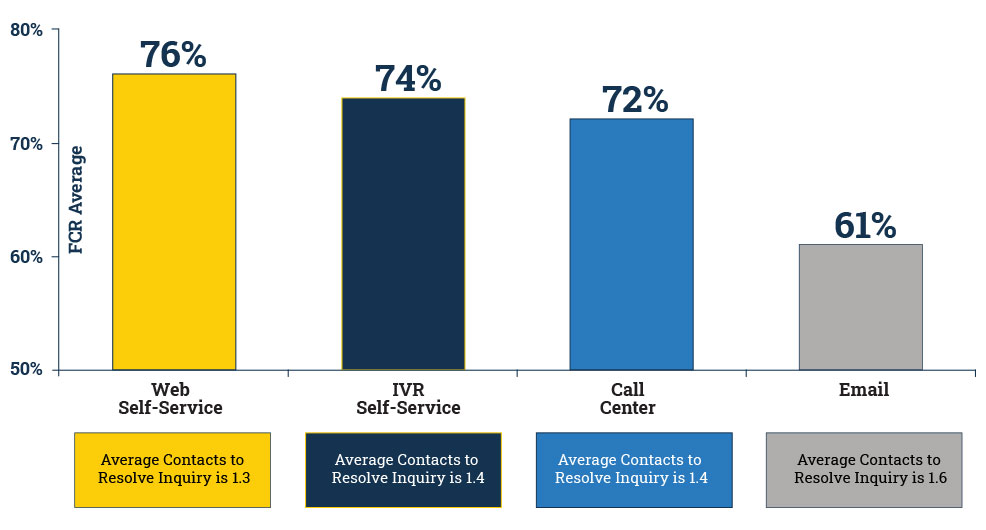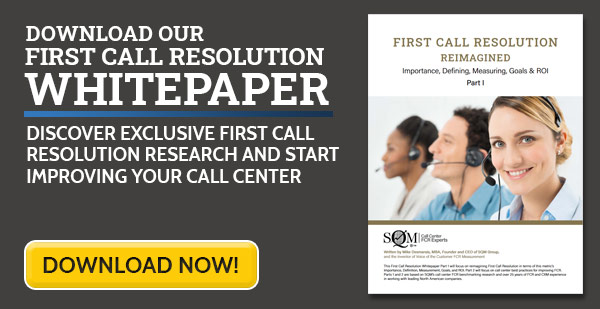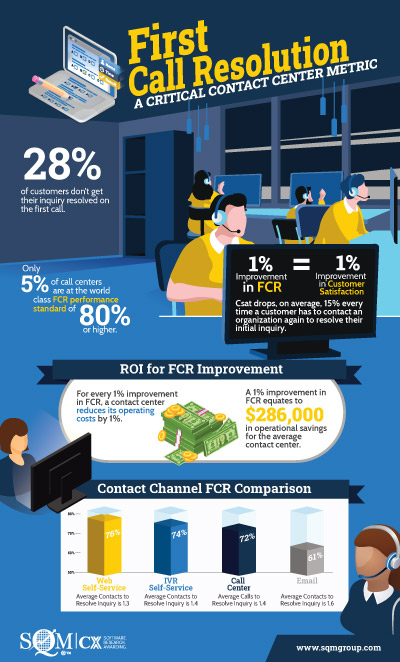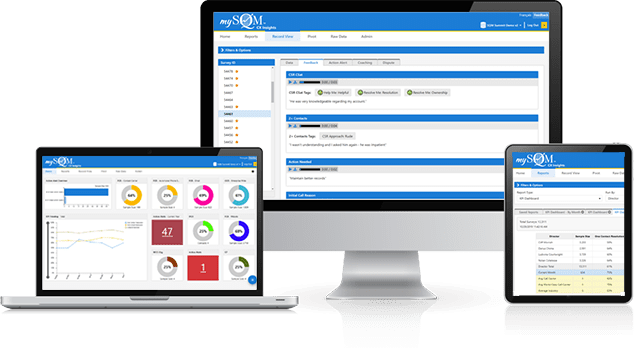Discover the Top 5 Reasons (+ a Bonus Reason) to Improve FCR
-
Reduce Operating Costs
For every 1% improvement in FCR, a contact center reduces its operating costs by 1%. For example if a contact center is performing at the FCR industry average of 72%, potentially 28% of customers will have to call back because their issue was not resolved on the first call. It is important to note that, for the contact center industry average, it takes 1.4 calls to resolve a customer’s inquiry or problem. However, for customers who do not achieve FCR, it takes on average 2.5 calls to resolve their call. This is an enormous opportunity to reduce a contact center’s operating costs as repeat calls represent 23% of the average contact center’s operating budget. To see how much you could save by improving your FCR, try our reliable ROI Calculator.
-
Improve Customer Satisfaction (Csat)
For every 1% improvement in FCR, there is a 1% improvement in Csat. FCR is the metric with the highest correlation to Csat and the absence of FCR is the strongest driver of customer dissatisfaction. In fact, Csat drops, on average, 15% every time a customer has to contact an organization again to get their initial iniquiry resolved. In other words, if a customer had to contact an organization three times to get their inquiry resolved, their Csat is 30% lower on average than a customer who had their initial inquiry resolved on the first contact.
-
Improve Employee Satisfaction (Esat)
For every 1% improvement in FCR there can be a 1% to 5% improvement in Esat. Contact centers with high FCR tend to have high Esat. Conversely, contact centers with low FCR tend to have low Esat. For example, the level of stress is very high for the customer service representative (CSR) handling the second or third contacts from a customer whose issue was not resolved on the first contact. Increasing FCR improves both Esat and Csat. When customer contacts are consistently resolved on the first contact, Esat can increase substantially, especially for low FCR performing contact centers. Most contact center managers connect to the concept that high Esat can provide high Csat/FCR, but it also goes the other way in that high Csat/FCR can provide high Esat.
-
Increase Opportunities to Sell
When a customer’s contact is resolved, it increases the customer cross-selling acceptance rate by up to 20%. SQM’s research shows that the customer’s needs must be resolved before the CSR has earned the right to move on to any type of sales activity. If the CSR cross-sells before the inquiry or problem is resolved, the customer typically becomes irritated and feels that the organization is pushing its needs, rather than serving the customer’s needs. As a result, the fundamental customer relationship is undermined.
-
Reduce Customers at Risk - Retaining Customers
Only 5% of customers who have their inquiry resolved on the first contact express their intent not to continue to use the organization’s products and services as a result of their customer experience (CX) with the contact center. However, if their inquiry is unresolved, 19% of customers express their intent to defect. The cost of customer defections as a result of their contact center experience is largely unknown by contact center managers because it is not often measured. For many contact centers, especially those in competitive industries, retaining customers represents the biggest opportunity to add value to their organization. Resolving calls is the key to reducing customers at risk.
Bonus Reason
Create More High Performing CSRs
For top FCR performing CSRs, the cost per call resolution is 35% lower than for the bottom FCR Performing CSRs. The contact center industry average cost per call is $9.10. Cost per call resolution factors in cost and how many calls it took for the customer's call to be resolved: the average cost per call resolution is $12.74. The average cost per call resolution for the best CSRs is $10.92 and for the worst CSRs is $14.56. The worst CSRs have a 33% higher cost per call resolution than the best CSRs. Creating more high performing CSRs is one of the best ways for lowering costs and retaining customers.
FCR Benchmark Data
Now that we have shared the Top 5 Reasons to Improve FCR, it is helpful to understand the FCR rate performance of core contact channels. Of the 500+ North American contact centers, SQM benchmarks annually based on conducting post-contact surveying methods, only 5% perform at the world class standard of 80% FCR or higher. The call center industry average for FCR rate is 70%. This means that 30% of customers have to call back the organization about the same inquiry or problem. A good first call/contact resolution rate is 70% to 75% and is applicable for all core contact channels except for the email contact channel, where a good FCR rate is 60% to 65%.
The below chart shows the FCR benchmark data comparison for core contact channels. The FCR benchmark data shows that web self-service (76%), IVR self-service (74%), call center (72% and email (61%). Web self-service and IVR self-service contact channels have the highest FCR performance because the contact reasons (e.g., orders, status updates, payment) are lower in complexity compared to the contact reasons the call center and email contact channels handle. In most cases, the email contact channel handles the highest complexity of contact reasons for all contact channels, and most customers who use this contact channel do so because it allows them to document their interaction. When an inquiry or problem is not resolved on the email, IVR self-service, or web self-service channels, most of those customers will phone the call center to resolve their issue. Therefore, the call center channel is the last line of defense for resolving an issue and, most importantly, retaining customers.
Contact Channel FCR Comparison

Call Center Research
Learn more on how to measure and define FCR for your contact center.SQM’s Voice of Customer research shows that improving FCR remains a huge opportunity for the entire contact center industry. Moreover, the opportunity to improve FCR spans all major contact channels.
Quick Related Links
First Call Resolution Definition First Call Resolution PPT First Call Resolution Benefits
First Call Resolution Strategies First Call Resolution Operating Philosophy Helpdesk First Call Resolution First Call Resolution Formula Calculate First Call Resolution Rate What is a Good FCR Rate? FCR Improvement Tips Agent CX Success Stories FCR Measurement Case Study



